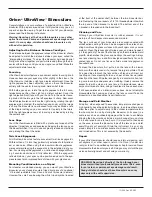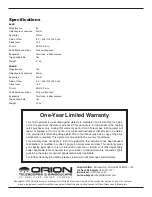
IN 066 Rev B 03/99
Orion
®
UltraView
™
Binoculars
Congratulations on your purchase of a precision Orion UltraView
binocular. With proper care and use it will provide many years of
superb, enjoyable viewing. To get the most out of your binocular,
please read the following instructions.
Warning: Never look at the Sun with binoculars or any other
optical instrument. Severe and permanent eye damage could
result. On sunny days, children should use binoculars only
with adult supervision.
Adjusting for the Distance Between Your Eyes
The distance between the eyepiece lenses of the binocular should
be adjusted to match the distance between your eyes, called the
“interpupillary distance.” To adjust the binocular, hold each barrel
firmly; move them together or apart while looking through the bin-
ocular with both eyes until you see a single, round field. Make this
adjustment before focusing.
Focusing
UltraView binoculars feature a convenient center focusing knob.
However, because your eyes may differ slightly in their focus, the
UltraView also includes a right eye diopter adjustment. Once the
right eyepiece has been adjusted, you can focus the binocular
entirely with the center focusing knob. Here’s what to do:
With both eyes open, rotate the right eyepiece to the full coun-
terclockwise position, then sight on a distant subject. Cover the
right objective (front) lens with your hand. Turn the center focus-
ing knob until the image in the left eyepiece is sharp. Now cover
the left objective lens and focus the right side by rotating the right
eyepiece (do not adjust the center focusing knob) until the image
is sharp. The binocular is now focused for your eyes. Make a note
of the diopter setting so you can return to it quickly in the future.
With the right eyepiece now set, focusing is achieved by rotating
the center knob.
Lens Caps
Your UltraView binocular is fitted with a plastic cap for each of the
objective (large) lenses and eyepieces. Keeping the lens caps on
the binocular when it is not in use will greatly reduce dust buildup
and prolong the life of the optics.
Twist-Lock Eyeguards
All UltraView binoculars feature convenient twist-lock eyeguards.
With less than a 1/4 turn they go from fully extended to fully retract-
ed, or vice versa. When using the binocular without eyeglasses,
we recommend leaving the eyeguards in the extended (up) posi-
tion. For viewing with eyeglasses on, retract each eyeguard turn-
ing it counter-clockwise until fully retracted. With the eyeguards
retracted (down), your eyes can be positioned closer to the eye-
piece lenses for an improved field of view with your glasses on.
Mounting Your Binoculars on a Tripod
For steadier or extended viewing, you can mount your UltraView
binocular on any standard camera tripod by means of an optional
“L”-bracket (available from Orion and most binocular dealers).
Unscrew the small cap bearing the white tripod symbol located
at the front of the center shaft, between the two binocular bar-
rels. Removing this cap reveals a 1/4"-20 threaded hole into which
the top end of the L-bracket is inserted. The bottom end of the
L-bracket is threaded onto the tripod itself.
Cleaning and Care
Although your UltraView binocular is rubber covered,
it is not
waterproof!
Avoid exposure to excessive moisture.
The lens surfaces of your binoculars are vacuum-covered with
antireflection coatings that can be damaged with careless han-
dling. Avoid touching lens surfaces with your fingers or any course
material. Clean the lenses about twice a year, and more frequent-
ly if they get dirty. The dust that builds up on them promotes mold
growth, which etches the glass and destroys the coatings. Always
use lens cleaning tissue and fluid designed specifically for multi-
coated lenses. Do not use tissue or fluids made for eyeglass or
household use.
To clean the binoculars, first puff air on the lens with a blower
bulb or with compressed air to remove the larger particles. Then
it’s a good idea to brush the lens with a soft lens brush. Next, put
two drops of lens cleaning fluid on a sheet of lens tissue (never
directly on the lens). Wipe the lens gently in a circular motion, tak-
ing care to avoid undue pressure or rubbing. Quickly remove the
excess fluid with a clean, dry lens tissue. On larger lenses, clean
only a small area at a time, using a fresh lens tissue on each area.
If dirt accumulates on an interior lens surface, do not attempt to
disassemble the housing and clean the lens yourself. Take the
binocular to a qualified optical repair technician.
Storage and Cold Weather
All optics, when exposed to excessive temperature changes or
high humidity, have the potential to fog up. In cold weather always
allow the optics to adjust slowly to the outdoor temperature for a
few hours prior to use by storing the binocular (in its case) in a
cool area such as an unheated garage or the trunk of a car. Before
bringing the binocular back inside a warm house after use, store
it in a cool area for one to two hours. It is important to then open
up the case, remove the binocular, take off the lens caps, and let
everything dry out overnight. Store the instrument in a cool, dry
place; storage in a humid environment will result in mold growth
and ruined optics. This is not covered by the warranty.
Repair
If your UltraView binocular should require internal cleaning, opti-
cal alignment, or other repairs, return it to Orion (if under war-
ranty) or take it to a qualified optical repair shop for service. Never
disassemble the binocular yourself. Doing so may disturb the pre-
cision optical alignment and will void your warranty.
WARNING: Never look directly at the Sun through your
binoculars without professionally made solar filters, even
for an instant, or permanent eye damage could result.
Young children should use these binoculars on sunny
days only with adult supervision.
















